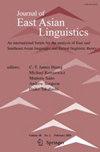Aspect shift without coercion: continuous causative verbs in Japanese and Korean
IF 0.5
3区 文学
0 LANGUAGE & LINGUISTICS
引用次数: 1
Abstract
This article discusses special agentive transitive verbs in Japanese and Korean (such as noru/thata ‘board’) that yield concrete result states (which we call target states) that are under the agentive subject’s control throughout their duration. These verbs (continuous causative (CC) verbs) produce two distinct interpretations: accomplishment and target state readings. The latter surface with several distinct constructions: (i) the aspectual morphemes -te iru (Japanese) and -ko iss (Korean); (ii) the simple past tense; and (iii) nominalization. Intuitively, what the agentive subject does is one continuous act: (i) attaining the target state in question, and (ii) preserving it. The name “continuous causative verb” stems from the fact that the agentive subject continues to behave like an agent throughout the complex eventuality. However, when we utter a sentence containing a CC verb, we either refer to the accomplishment portion or the continuation of the target state, not both at the same time. Our formal proposal posits an aspect shift rule in the lexicon, which is responsible for the target state reading of each CC verb. The target state is indicated by a relation that holds between the agent and the theme entity, which in turn predicts that the agent is responsible for keeping the state intact. Positing a semantic rule in the lexicon to predict the aspect shift allows us to account for the two interpretations of CC verbs. The behavior of temporal adverbials also receives a natural account in our proposal.无强迫的时态变换:日语和韩语的进行式使役动词
本文讨论了日语和韩语中特殊的代理及物动词(如noru/that ' board),这些动词产生具体的结果状态(我们称之为目标状态),这些状态在整个过程中都受代理主语的控制。这些动词(连续使役动词)产生两种不同的解释:完成和目标状态读数。后者表面有几个不同的结构:(i)面相语素- The iru(日语)和-ko iss(韩语);(ii)一般过去时;(三)名词化。直觉上,代理主体所做的是一个连续的行为:(i)达到有问题的目标状态,(ii)保持它。“连续使役动词”的名称源于这样一个事实,即在复杂的可能性中,施动主体继续像施动主体一样行为。然而,当我们说出一个包含CC动词的句子时,我们要么指完成部分,要么指目标状态的继续,而不是同时指两者。我们的正式建议在词典中假定了一个方面转移规则,该规则负责读取每个CC动词的目标状态。目标状态由代理和主题实体之间的关系表示,这反过来又预测代理负责保持状态的完整性。在词典中设置一个语义规则来预测方面的变化,使我们能够解释CC动词的两种解释。在我们的建议中,时间状语的行为也得到了自然的解释。
本文章由计算机程序翻译,如有差异,请以英文原文为准。
求助全文
约1分钟内获得全文
求助全文
来源期刊

Journal of East Asian Linguistics
Multiple-
CiteScore
0.90
自引率
0.00%
发文量
13
期刊介绍:
The study of East Asian languages, especially of Chinese, Japanese and Korean, has existed for a long time as a field, as demonstrated by the existence of programs in most institutions of higher learning and research that include these languages as a major component. Speakers of these three languages have shared a great deal of linguistic heritage during the development of their languages through cultural contacts, in addition to possible genealogical linkage. These languages accordingly possess various common features. Another important factor that ties them together as a field is that they have shared a common tradition of linguistic scholarship, a tradition that distinguishes itself from the study of western languages. Against this tradition, much recent work has approached these languages from a broader perspective beyond the area, considering them within contexts of general theoretical research, bringing new lights to old problems in the area and contributing to current issues in linguistic theory. But there continues to be good reason for scholars working in this approach to hold a special interest in each other''s work. Especially with the amount of most recent theoretical work on these languages, the field of theoretical East Asian linguistics has been fast growing. The purpose of the Journal of East Asian Linguistics is to provide a common forum for such scholarly activities, and to foster further growth that will allow the field to benefit more from linguistic theory of today, and enable the languages to play a more important role in shaping linguistic theory of tomorrow.
 求助内容:
求助内容: 应助结果提醒方式:
应助结果提醒方式:


